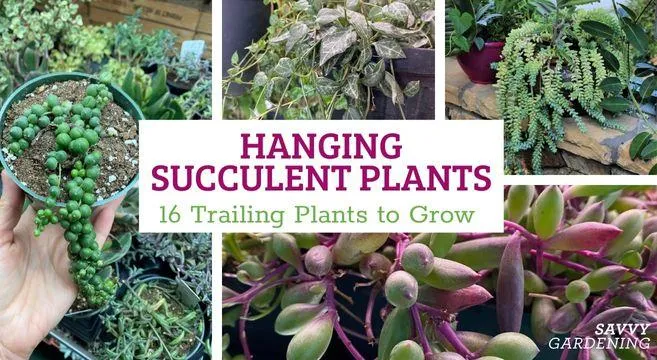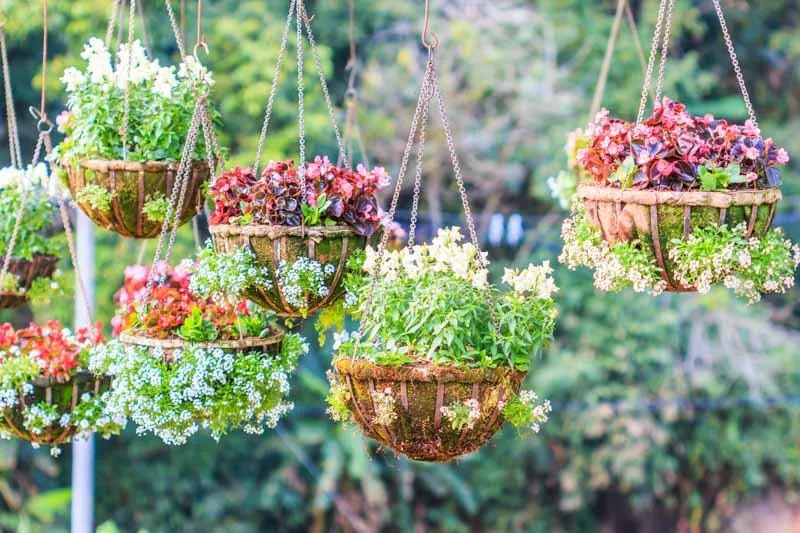The Best Trailing Plants for Your Home and Garden
If you’re looking to add some gorgeous greenery to the edges of planters, hanging baskets, or walls in your outdoor space, trailing plants are an excellent option. They cascade over the sides of containers or along fences and trellises, spilling colorful blooms or decorative foliage. In this article, I’ll cover some of the top trailing plants to consider and help you decide which ones are best suited to your needs.
English Ivy
One of the most commonly used trailing plants is English ivy (Hedera helix). Its leaves come in various sizes and shapes, from small ovals to bigger heart shapes. In fall, its foliage turns beautiful shades of reds, yellows, and browns. English ivy thrives in partial shade but can also handle full sun with adequate moisture. It’s an aggressive grower that will quickly cover walls, arbors, or ground. While its vigorous growth is nice for covering areas, it’s important to keep it from invading other planting beds where it could become invasive. English ivy is very durable and tolerant of most climate conditions. It’s also attractive to wildlife as shelter and a food source.
Creeping Jenny
For brightening shady spots, creeping Jenny (Lysimachia nummularia) is a top choice. As its name suggests, it creeps along the soil surface, spreading to form a dense green carpet punctuated with small yellow flowers throughout spring and summer. Creeping Jenny thrives in partial to full shade and keeps its attractive rounded foliage even in poor, dry soils. It’s one of the toughest and most forgiving groundcovers you can find. Creeping Jenny spreads quickly via fleshy stolons to fill in bare patches. It’s an excellent option for masking plant crowds at the base of trees or spilling over rock walls and retaining walls in shady sites.
Vinca Vine
With its dense mats of green foliage dotted with cheery blue, pink, or white flowers almost nonstop from spring to fall, vinca vine (or periwinkle, Catharanthus roseus) is a wonderful trailing plant for sun. It adapts well to heat and humidity, thriving in zones 7-10. While it spreads quickly via runners to form an extensive colorful carpet, vinca is not invasive like English ivy. It works beautifully flowing over stonewalls, banks, and mixed into flower borders where it can spill over the edges of raised beds. Another nice quality is its adaptability—vinca will even tolerate partial shade in hotter climates. For low-maintenance color, vinca is a superb choice.
Fuchsia
In warmer zones 6-10 with at least partial sun, fuchsias offer trailing blooms in captivating shades from vivid reds to purples, pinks, and oranges. Their pendulous flowers dangle below waxy green leaves on arching stems. Fuchsias look lovely pouring over walls, along fences, or hanging from baskets. They thrive in organic, moisture-retentive soil. Providing some afternoon shade in hotter areas will help protect their blossoms. Deadheading spent blooms encourages repeat flowering. A bushy plant can be pruned back each year following blooms to maintain an attractive trailing shape. Fuchsias brighten any space with their vivid colors and busy blossoms throughout summer.

Moneywort
Moneywort or five-finger plant (Lysimachia nummularia) is a very unique trailing groundcover. Its rounded leaves come arranged alternately along its creeping stems to resemble coins, hence its common “moneywort” moniker. Delicate yellow flowers pop up along the stems in summer. Moneywort spreads rapidly via stolons and roots where nodes touch soil. It excels in sun or partial shade with average, well-draining soil. Moneywort forms a dense carpet that chokes out weeds. It’s tolerant of poor soils and moisture fluctuations, making it low-fuss to grow. The neatly overlapping coin-shaped leaves give subtle texture for sheltered paths, among stonework, or cascading from the tops of retaining walls.
Petunias
For trailing color that lasts all season long, petunias deserve a spot on any list of best trailing plants. Given full sun and regular water, petunia vines will burst with single or double blooms in a rainbow of wild colors from classic reds and pinks to blues, oranges, and purples. Train their flexible stems along the tops of stone walls, over trellises and arbors, or let them flow beautifully from hanging baskets. New improved hybrid varieties resist fungal disease better than older types and have larger, longer-lasting blooms. Deadheading spent flowers stimulates repeat flowering until frost. The cheerful display of petunias makes them an ideal choice for those seeking trailing flower power.
Lantana
For tough, carefree color even in hot, sunny spots, lantanas (Lantana camara) can’t be beat. Their tough woody vines are cloaked in rounded leaves and topped with clusters of small blooms in captivating solid or two-toned combinations of red, orange, yellow, pink, and purple. Hummingbirds flock to lantanas’ sweet nectar. They offer nearly year-round color in frost-free zones 9-11 and thrive despite drought, heat waves, and poor soil with minimal care. Lantanas look amazing cascading from hanging baskets or containers, blanketing arbors or garden walls with Flowers. Their attractive rounded leaves also provide nice texture and visual interest when not in bloom. For hot Southern gardens seeking beautiful trailing plants, lantana is tough to surpass.
Wandering Jew
With trails of silvery green or deep purple foliage dotted infrequently with small pink or white flowers, wandering Jew or inchplant (Tradescantia zebrina) makes a lovely choice for trailing shade or semi-shade. It’s one of the hardiest and easiest to grow. Just give it partial sun and average moisture. Let the vines spill freely over retaining walls, fill urns, or trail along the ground. Its grass-like foliage offers subtle texture. Other cultivars like ‘Purple Heart’ have stunning iridescent deep purple leaves. Wandering Jew grows and spreads vigorously via stolons, providing dense coverage quickly to battle weeds and brighten sheltered spots. It’s suitable for growing indoors in pots too for its ease of care.
Nasturtiums
Sun-loving nasturtiums offer trailing flowers in shades from yellow to bright reds and oranges along vines growing 4-6 feet long. The flowers are cute with petal edges scalloped or crinkled like tissue paper. Their leaves taste mysteriously of peppery mustard. Train nasturtium vines on fences and trellises, or let them run along the ground. Beyond adding color, this edible trailing plant attracts pollinators and its leaves can be used in salads. The flowers also make lovely tabletop garnishes. Give nasturtiums full sun and well-draining soil for their long flowering displays into fall. They’re lower-maintenance than many trailing plants while providing benefits of beauty, flavor, and pollinator habitat.

Choosing the Right Trailing Plant for Your Space
To decide which trailing plant is best for your specific landscape needs, consider light levels, hardiness zone, availability of watering, and whether the plant spreads quickly or slowly. English ivy, vinca vine, and lantana are top picks if you want something fast-spreading to rapidly cover large spaces. For shadier nooks, creeping Jenny, moneywort or fuchsia would suit better. If you have hanging baskets or containers, petunias, lobelia and nasturtium make dazzling trailing flowers. Wandering Jew, pothos or spiderwort excel for indoor containers too. With so many gorgeous options that offer trailing blooms, foliage, or both, finding the right match is a breeze!
It’s amazing how trailing plants can transform otherwise plain spaces or fill in challenging bare spots in your landscape. Whether you want something low-maintenance or prefer a burst of seasonal blooms, these versatile vines provide beauty from above and below. With the right plant selections for yourconditions, trailing greenery can make balconies, patios and gardens much more lush, colorful and inviting all season long. Just be sure not to let aggressive spreaders like English ivy get out of control. With a little TLC, trailing plants will reward you with years of lovely spillover color!
I hope this guide helped give you some excellent ideas for
Top Trailing Plants for Shade Gardens
| Plant | Sun | Height | Color | Care Level |
|---|---|---|---|---|
| Wandering Jew | Partial shade | 6-12 in. | Purple, green, silver | Easy |
| Swedish Ivy | Shade | 12-24 in. | Green | Low |
| Wax Begonia | Partial shade | 6-12 in. | Red, pink, white | Easy |
| Periwinkle | Shade | 6-12 in. | Blue, white | Low |
| Wintercreeper | Partial shade | 2-4 ft. | Green | Low |
| Lilyturf | Shade | 4-6 in. | Variegated green and white | Low |
FAQ
-
What are the best trailing plants for hanging baskets?
Varieties of petunias and verbenas are sort of usually good choices since they basically cascade over the edges. Geraniums also hang down well and come in a wide diversity of colors. Wave petunias are pretty unique becuase they almost resemble little flags fluttering in the breeze.
-
Do trailing plants require more or less water than other plants?
Trailing flowering plants typically need a bit more water than others. Their long, flowing nature means the soil dries out rather quickly. It’s best to check the soil everyday and water when the top inch becomes dry. On the other hand, overwatering may cause root rot issues. A daily squeeze is generally better than soaking the whole basket at once.

-
How can I encourage trailing plants to grow longer?
Provide trailing plants with the best growing conditions will help stimulate bigger and longer growth. Make sure to choose a spot with at least 6 hours of direct sun every day. Fertilize monthly during the growing period using a water soluble plant food. Pinch off dead blooms to encourage new growth. Staking or trellising can also help train vines to fill out more fully.
-
What is the best way to plant trailing plants in a hanging basket?
Most garden centers sell hanging baskets pre-planted, so go with that for convenience. Otherwise, starting with a coconut coir-based growing medium works well. Place your plants in first, then fill in around and between them. Be sure the roots are completely covered but the crowns stay above the soil line. Give them a good water to settle in. Check roots aren’t bound before hanging.
-
How often should I rotate my hanging baskets?
Giving hanging baskets a quarter turn each day encourages them to grow symmetrically. This helps plants on the north side get the same sunlight as those on the south side. Rotating also prevents one side from becoming heavier and lopsided. It solely takes a few seconds but can make your baskets look much fuller and healthier overall. Who knows, maybe the plants even get dizzy!
-
What can I do if my trailing plants aren’t very full or bushy?
If new growth seems a bit sparse, there are some things to try. Cut back leggy stems by about a third to encourage a more compact form. Pinch off faded flowers to redirect energy into producing fresh foliage. Switch to a flowering plant food during the growing months. Moving the basket to a spot with more direct sun might also help things fill out. Otherwise, simply give it some more time. Plants can take a while to thrive after being moved.
-
Is it best to deadhead trailing plants or let them set seed?
Constantly removing dead blooms promotes repetition flowering, nearly at amazing levels! Seeds usually aren’t desirable on these basket beauties so deadheading extends their show. Letting flowers go to seed may diminish future reblooming. Leaving seed pods on could likewise cause a plant to put its strength into ripening seeds instead of forming new buds. Thus, it’s advisable to snip offspent flowers regularly for continuous color all season long.

